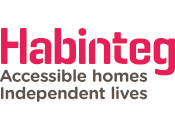
Adapting your home: access into and around your home
Adapting your home: access into and around your home
This factsheet is available for sponsorship, email marketing@dlf.org.uk
Sponsorship has no influence on our impartial content
Factsheet contents
- Introduction
- Your individual needs
- Approaching your home
- Parking
- Paths
- Visual access
- External lifts
- Adapting entrances
- Opening the door
- Door handles
- Automatic power assisted door opening systems
- Door entry intercom systems
- Getting through the front door
- Thresholds
- Weather protection
- Threshold ramps
- Portable or removable ramps
- Semi-permanent ramps
- Getting around indoors
- Storage and charging space for wheelchairs
- Getting up and down stairs
- Provision of equipment
- Further advice from us
- Contributors
- Useful organisations and resources
- References and further reading
Introduction
There are a number of features that may make it more difficult to get in and out of your home and to get around indoors. This might include:
- narrow door openings or heavy doors
- raised thresholds and steps
- steep or sloping paths and driveways
- narrow corridors
- changes in levels
- stairs.
This fact sheet provides guidance on what you need to consider when planning adaptations, depending on what difficulties you have, and provides suggestions for adaptations to make it easier and safer for you to:
- approach your home
- get in and out of your home
- get around inside your home
Please also see DLF's fact sheet, Choosing equipment to get up and down the stairs.
Your individual needs
Everyone is different and will have different needs and priorities. When planning an adaptation to improve access, especially if it requires extensive and permanent construction, there are a number of factors to consider:
- Will the adaptation meet your needs in the long term?
- If your abilities vary from day to day, will the adaptation meet your needs on days when you have the most difficulties?
- If you use a walking frame or wheelchair indoors, how much space do you need to get around? Is your wheelchair self-propelled or powered?
- If you rely on a walking frame or wheeled walker outdoors do you need step free access?
- If you find steps are very difficult, do you need rails?
- If you sometimes need to use a wheelchair how do you get it over the threshold?
- Does it or will it meet the needs of other people living in the house?
Barriers to easy access into your home
Making it easier and safer to access your home will depend on a number of factors:
- Do you live on a steep and sloping site?
- Do you have steps up to your front door?
- Does the front door have a raised threshold?
- If you live in a flat above ground level, do you have lift access?
- How close can you park your vehicle?
There are a variety of conditions that can impact on your ability to get into and around your home. You may have difficulties with:
Mobility
- Reliance on support of rails to get up and down steps, over thresholds or up and down stairs
- Reliance on a walking frame, walking stick or crutches for support
- Using a wheelchair to get around
- Using a wheelchair to go further distances outdoors
Grip strength
- Difficulties operating keys, locks and door handles
Visual access
- Sight loss that makes it difficult to locate your front door and find your way around your home
Memory, orientation and understanding
- Difficulties with memory and understanding, that make it increasingly difficult to find your way around and recognise your own front door, find and use key facilities such as the toilet and find key items in your kitchen or bedroom
- Are you or the person you support aware of safety aspects, or do you/they require supervision inside or outside of the home?
Approaching your home
Parking
Whether you are able to drive, or rely on someone else to drive, you may have difficulties getting from the car to your front entrance.
Off street parking
If you live in a house you may have a driveway with space to park a car off the main street. If you are using a wheelchair or walking aid, you will need sufficient space to the side or to the rear of the car to get in and out safely.
Parking bays accessible for wheelchair users
For wheelchair users a minimum width of 1200mm to the side and rear of the parking area is recommended. The additional space is to allow for ease of approach to get in and out of the car from the side or rear depending on what kind of vehicle you have. Some wheelchair accessible vehicles are accessed via a ramp or lifting platform from the rear.
N.B - cars and adapted vehicles may be different lengths and widths - for example ambulance or community transport providers may use larger vehicles. Also if you require assistance of someone to get in and out of the vehicle that will increase the space you require as well.
Further guidance is laid out in the Building Regulations Approved Document M (4) 3 and Vol. 1 and the Wheelchair Housing Design Guide (3rd Edition)
Access to roadside parking
If you are a wheelchair user and the drive is sloped, it will be more difficult to be assisted to approach and get in and out of your car, due to the risk of you rolling forwards or backwards. You may need to adapt the front access with ramping so that you can get to the roadside and into the car from the pavement
If you have limited mobility, it may take you longer than usual to get in and out of your car. Covered parking can protect you from the weather - for example car ports and open covered porches
Consider lighting for dark and winter nights.
On street parking
Many areas of towns now have paid residents parking. However this does not guarantee you a parking space outside your home.
Blue Badges
A Blue Badge will entitle you, or the person who is driving you, to park without penalty or charge, in many parking areas. There are some local variations in different councils, as to where you are entitled to park. If you are in receipt of any of the following, you will automatically qualify for a Blue Badge:
- Higher rate of the Disability Living Allowance
- Personal Independence Payment for being unable to walk more than 50 metres
- Are registered blind
- Receive a War Pensioner’s Mobility Supplement.
 You may still be eligible if you have a permanent and substantial disability that means you are unable to walk, or if you are unable to walk very far without experiencing considerable difficulty. In 2018 the eligibility for Blue Badges in England was revised to include ‘hidden disabilities’ such as mental health and autism with changes due to be introduced in 2019.
You may still be eligible if you have a permanent and substantial disability that means you are unable to walk, or if you are unable to walk very far without experiencing considerable difficulty. In 2018 the eligibility for Blue Badges in England was revised to include ‘hidden disabilities’ such as mental health and autism with changes due to be introduced in 2019.
Details on eligibility and how to apply are laid out in the Department of Transport Guidance: Can I get a Blue Badge? If you think you might be eligible you can contact the Blue Badge Initial Enquiry Support Service on 0844 463 0213.
Local authorities administer Blue Badges and you can contact them to ask for an application form or you can apply online.
Disabled Parking Bays
If you find it difficult to get from the car to your home and you do not have off-street parking, you may be entitled to have a marked Disabled Parking Bay outside your home. You will need to contact your local council to find out if you are eligible. If this is provided it will be available for use by ANY Blue Badge holder and so does not provide dedicated parking.
Approach routes: Paths
Surface and slip resistance
It is important to ensure that surfaces of paths are level or gently sloping, well maintained and kept free of moss or any other plant materials that may increase the risk of slips. The ground surface should be even, smooth and free of loose materials such as gravel, that can make it more difficult for wheelchair users or people reliant on walking frames or sticks.
Widths of paths
The width of a path will depend on your mobility, whether you need to use a walking frame, wheeled rollator, wheelchair, or mobility scooter. Also consider if you require assistance of someone when walking as this will increase the required width.
Sloping paths and steps
- If you are able to walk but have difficulty managing slopes a handrail can provide additional support.
- If the path is steep, many people who have some difficulty walking find one or two low steps easier to manage. If you are reliant on a walking aid, you need to consider if you will be able to lift the aid, and to ensure the steps are large enough for you to stand comfortably with a walking aid.
Steps and rails
If you have difficulty managing steps, you may benefit from the support of rails. If there is only one step to your front door a simple grab rail in a vertical position on one or both sides of the door may be sufficient. If the height is more than 360mm (36cm) handrails are recommended. A grab rail needs to be positioned at a height that is comfortable for you.
If you have more than one step it is recommended that you use an external handrail. Depending on how much support you need, you may need a rail on one or both sides. This rail may be made of metal or wood but should provide insulation against the cold and should be slip resistant to the touch.
If there is not a suitable fixing on the wall, for example if you have an outside porch, it may be possible to install a rail that is fixed to the top step instead of the wall. The College of Occupational Therapists (2006) Minor adaptations without delay provides information that can help in the positioning of rails. This guide is intended for housing associations involved in fitting ‘minor adaptations’ for tenants, such as stair rails. It gives technical specifications and examples of good practice.
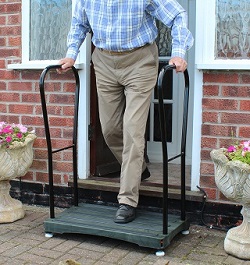 Size and dimensions of steps
Size and dimensions of steps
It is always easier to manage if the height and depth of steps are of equal size. If your steps are uneven, having the steps changed to equal dimensions will make it easier and safer. It is also important to ensure that the steps do not have an overhang that could catch your feet. Recommendations on the dimensions for steps are given in Approved Document K of the building regulations.
Half steps
If you have a high step into your home, constructing an additional half step may help. It is important to ensure that these two steps are of equal height.
Size of steps for use of walking frames
In the UK there are no existing guidelines for the size of steps for using walking frames. However as a general guide, the Home Modification Information Clearing House website provides useful guidance:
- Riser height: 95-105mm
- Tread depth: 575 - 600mm
- Strip of colour contrast on step nosing (to enable easy identification of the edge): 50-75mm
Visual access
It is important to ensure that the front entrance is easy to see and locate. This is especially helpful for people who have any kind of sight loss or difficulties with memory, or recognising their own front door. A clearly defined and labelled front entrance makes it easier to locate.
Factors to consider to improve visual access
- Good lighting can make it easier and safer to negotiate steps but also to locate and operate the lock. It also helps you to be able to see visitors when you are answering the door. Lighting is especially important for those with any kind of sight loss. It can also help people who have difficulties with memory in recognising their own front door.
- External lighting at the front door and to light steps, ramps or paths will makes it easier and safer when you are approaching your front door. This could be:
- a light that comes on automatically when you approach the door
- lights that come on automatically when the day light levels are low at different times of the day.
- Visual contrast makes it easier to locate your front entrance. This includes:
- strong visual contrast between the door and the frame
- strong visual contrast between the frame and the wall
- strong visual contrast between the key hole and lock and the door
- large and raised number plate that contrasts to the back ground (e.g. black numbers on a light door or white numbers on a dark door)
- If there are steps a strip of lighter colour on the edge of the steps (for example white or yellow) will make it easier to see the shape and size of the steps.
Further reading: Designing House Entrances for People with Sight Loss: A Guide by Thomas Pocklington.
External lifts
If you use a wheelchair and have steps to your front door but there is not enough room to install a ramp, you may need to install an external lift.
External lifts: considerations
- Is there sufficient space to install a lift?
- Will it obstruct access for ambulant users?
- Is the lift large enough to take your wheelchair?
- Is the lift large enough to take your wheelchair and an assistant?
- Do you need assistance to operate your wheelchair?
- Are you able to operate the controls?
- Does the lift fold out of the way when it is not in use?
- Can the lift be locked when it is not in use?
- Will you need to provide additional steps or access for other users?
External lifts have a platform that is large enough to accommodate a wheelchair and an assistant, and have rails on two sides. They may also have integral steps. These move vertically and are useful for short rises, for example beside steps. Dependent on the space available, these lifts can be installed indoors as well as out.
There are a number of lifts available that can be fitted outside, either next to or on the steps:
- Vertical lifts include a platform that can accommodate a wheelchair. Some of these allow for enough space for an assistant (another person)
- Inclined lifts can have a platform that carries a wheelchair, or a seat to carry a person, like an internal stairlift.
There are two types of platform lifts:
- Short rise platform lifts are suitable for shorter vertical lifts up to 1000mm
- Platform lifts that can travel longer vertical distances.
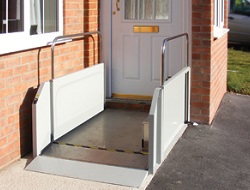 Short rise lifts can be used indoors or outdoors where there is a change in levels, for example at a front step or in a split-level hallway. They have a platform that is large enough to accommodate a wheelchair. They may be open, or enclosed on two or four sides. These lifts move vertically and are useful for short rises. Some short rise lifts are able to carry both the wheelchair user and carer.
Short rise lifts can be used indoors or outdoors where there is a change in levels, for example at a front step or in a split-level hallway. They have a platform that is large enough to accommodate a wheelchair. They may be open, or enclosed on two or four sides. These lifts move vertically and are useful for short rises. Some short rise lifts are able to carry both the wheelchair user and carer.
When choosing a lift and which features best suits your needs, an individual assessment with an occupational therapist is strongly recommended.
Inclined platform step lifts
These lifts are another option if there is not room for a vertical step lift. They are mounted on a track in a similar way to a stair lift and have a compact folding platform to support a wheelchair user.
Inclined chair step lifts
These lifts are like stair lifts but are suitable for fitting outside. If you are reliant on a wheelchair for outdoors you will need to consider whether you have room to store a wheelchair or mobility scooter at ground level, or whether you need assistance to carry it down the steps. If you are unable to do this, an inclined platform lift that will accommodate a wheelchair may be a better option.
Adapting entrances
In order to make it easier and safer to get in and out of your home, you may need adaptations to a front entrance and/or back entrance to garden, patio or balcony. If you live in a flat you may need to request adaptations to a communal entrance.
Factors to consider when adapting an external entrance
- If you have a porch you may have to get through two doors: from the outside into the porch and then into the front door
- If you have a small porch and both doors have high thresholds or steps this may be difficult or impossible if you are using a wheelchair
- Some people only use wheeled walking aids when walking outdoors and keep these in the porch. However, if this is in view from the outside this may be considered a security risk.
Opening the door
Opening the door, operating locks and handles can be difficult if you have:
- limited strength, power and grip in your hands
- only have the use of one hand
- limited reach
- sight loss
- a door that is stiff or heavy to open.
When looking to make it easier to unlock and open your front door consider the following:
- Can you get close enough to the door to open it from the inside and outside?
- Are you able to hold and turn a key?
- Are you able to reach and operate the door lock?
- Does the existing locking system require two hands to operate?
- Are you able to push the door open and close it behind you?
- Does the door swing closed before you have been able to get through it?
 Holding and turning the key in the lock
Holding and turning the key in the lock
If you have difficulty using a key due to limited strength in your hands, there are products that can be attached to keys to make it easier for you to hold and turn the key in the lock.
Key turners fit to your existing key to extend the size and give you a more comfortable grip and better leverage.
Door handles
N.B - If you are looking to replace doors, particularly security doors, be sure to try out the locking mechanism before purchasing.
Some five lever locks on uPVC doors require two movements - lifting the handle and turning of the key - which some people find difficult to do.
Many people find doorknobs difficult to turn. Lever door handles can be easier to operate and do not generally require a strong grip.
Factors to consider when selecting door handles:
- Does the lock require you to lift the lever and if so are you able to do this?
- Are you able to grip the handle?
- Can you operate the handle with the palm of your hand?
- Is your hand likely to slip off the end of the door handle?
If your hand is likely to slip off when you are pushing a handle down to open it, then a door knob turner may make it easier to operate. These can be fitted onto existing door knobs. Alternatively you can replace the existing door knob with a lever handle.
Automatic power assisted door opening systems
If you are unable to reach or operate the lock with a conventional key or turn a door handle, or you are unable to get close enough to the door to open or close it, you may benefit from having an automatic opening door fitted.
Factors to consider when selecting an automatic opening door:
- Will the automatic opener be compatible with the locking system?
- Is there enough room for you to move away from the door swing?
- Can you hold and operate a handheld fob?
- Could the remote control be fixed to your wheelchair if you are unable to hold it? Do you need to operate the remote by suck or puff?
- How near do you need to be to the door for the remote control to work?
- Will the automatic opening be on a timer? (e.g. to stay open for a certain length of time then automatically close)
- Can you program the door to stay open (e.g. if it is a back door and you want to leave it open in warm weather)
- How will the door be operated in the event of a power cut or fire?
Doors with controlled door closing
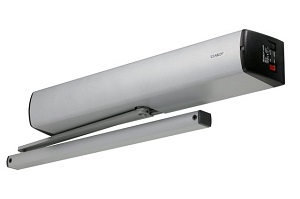 The doors are designed to automatically close after they have been manually opened. Many people who use wheelchairs or walking aids can find it difficult to push open these types of doors due to the 'spring shut' mechanism.
The doors are designed to automatically close after they have been manually opened. Many people who use wheelchairs or walking aids can find it difficult to push open these types of doors due to the 'spring shut' mechanism.
Free-swing door openers
If the door is too heavy for you to open, it may be possible to change the opener and hinges so that the door swings open freely. If you are living in a flat, you will need to check that this complies with fire regulations.
Door entry intercom systems
 If you have difficulty walking it may take you some time to get to your front door. Many people benefit from having a door intercom system.
If you have difficulty walking it may take you some time to get to your front door. Many people benefit from having a door intercom system.
There are a number of things you need to consider when selecting the right intercom system for you. Some models simply allow you to speak to the visitor or have video links so that you can see who the caller is. Some also allow you to remotely release the door lock to let them in. Some can be set up via an app and integrated with your smart phone or tablet.
When choosing a door entry intercom system also consider the following:
- If you require door release, what kind of door do you have? E.g. if it's uPVC (plastic door and frame) you will need to ensure that the system is compatible with this type of door
- Can you operate a wall-mounted handset or would a portable handset be more convenient?
- What is the most convenient place to position the handset and do you need more than one? (E.g. in you lounge, near to your arm chair, in your bedroom next to your bed)
- Can you operate the buttons/switches on the handset?
Getting through the front door
You may have difficulty getting in and out of you front door if it is too narrow, heavy, or has a high threshold.
Thresholds
If you have difficulty walking, the threshold can present a trip hazard or an obstruction if you are using a walking aid or a wheelchair.
Accessible thresholds
The Building Regulations (ADM-Vol 1) defines an accessible threshold as one where the total height does not exceed 15mm, and recommends that any up stand greater than 5mm is chamfered (curved profile) to ensure that a threshold is wheelchair accessible. It is useful to refer to the Building Regulations (Part M).
It is also important to ensure that the profile of threshold is rounded so that there is not an abrupt up stand that could cause an obstruction or trip hazard.
The minimum requirements are:
- If a raised threshold is unavoidable, the up stand should not exceed 15mm (1.5cm)
- The profile of the threshold should not be square
- Any part of the profile higher than 5mm should be rounded.
Internal surfaces at the threshold such as thick doormats can impede wheelchair access or use of wheeled walking frames or adult and children's walking aids. However it may be important to have an effective low pile door mat to remove rain water and/or dirt from the wheels of the wheelchair or walking aid.
Threshold types
How easy it is to lower or remove a threshold will depend on what type of door you have:
- If you have a conventional timber door and frame, the threshold can be lowered or removed and the existing door can be enlarged with an addition of a timber strip
- If you have a uPVC or composite door, the whole frame will need to be replaced with one with a low threshold.
Weather protection
The function of thresholds at front entrances is to provide weather protection. If the threshold is lowered or made level, it is important to ensure that you make provision for weather protection. This can be done by:
- Installing a drain that provides a means for rainwater to soak away. There are a number of products available, but you would need a contractor to install them
- Ensuring there is a slight gradient sloping away from the entrance.
There are a number of level threshold products that can be fitted to existing door sets or installed as new door sets, which ensure a weatherproof seal whilst providing a level or low threshold. It is important to ensure that these are Part M compliant.
If you are a wheelchair user and/or have difficulty operating a lock and opening the door, it is worth considering whether it is feasible to construct a canopy above the door, to provide you with shelter while you are unlocking the door.
Threshold ramps
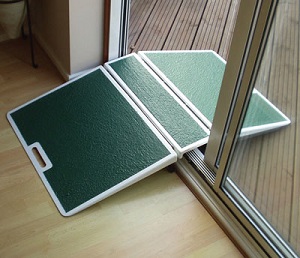 If you are using a wheelchair or are being assisted to use a wheelchair, a threshold ramp may make it easier for you if you are not able to lower or remove your threshold.
If you are using a wheelchair or are being assisted to use a wheelchair, a threshold ramp may make it easier for you if you are not able to lower or remove your threshold.
Factors to consider when selecting a threshold ramp
- How high is your threshold?
- Do you have sufficient space on both sides of the threshold to position the ramp?
- Is it possible to close the door with the threshold ramp in place?
- Do you need assistance to position the ramp each time you enter and leave your home? Consider if a two-sided threshold ramp could be an option
- How much does the threshold ramp weigh?
- Can it be stored out of the way when not in use?
- Does it have a slip resistant surface?
- How durable is it?
If you are purchasing the threshold ramp yourself, finding the best solution will depend on the dimensions of your threshold, the space available, and whether or not you can manage the slope with your wheelchair. If you are unsure of exactly what you need, some companies will provide a home demonstration service before you buy:
Some Local Authority Adult Social Care or Children’s Occupational Therapy Services provide threshold ramps free of charge, following an assessment of your needs.
Portable or removable ramps
If you wish to arrange a private appointment with an occupational therapist then you can obtain details of local Health Care Professions Council (HCPC) registered private occupational therapists from the Royal College of Occupational Therapists website or phone their enquiry line on 0845 129 7699.
N.B: If you think that a ramp would meet your needs, it is recommended that you seek an assessment to ensure the right piece of equipment is provided as portable/removable ramps can be particularly dangerous.
Contact your local Social Services or Children’s Service to request a OT assessment or alternatively you could arrange a private OT assessment via the Royal College of Occupational Therapists' website
Factors to consider when planning to install or purchase ramp:
To construct a ramp that will comply with building regulations it is strongly advised that you select a contractor who is familiar with the requirements.
- What is the difference in levels between your entrance and the path?
- Is the path level?
- How steep will the ramp be?
- Is there enough space to create a level platform outside the door?
NB: If you do not use a wheelchair but have difficulty walking you may find a ramp more difficult than steps.
There are different options for installation of ramps:
- Permanent
- Semi-permanent/temporary. Usually made from reinforced plastic, steel or fiberglass
- Modular. Usually more suitable for smaller and threshold ramps.
 In order that they are as safe and easy as possible to use it is recommended that the dimensions and gradient of the ramp complies with the following guidance:
In order that they are as safe and easy as possible to use it is recommended that the dimensions and gradient of the ramp complies with the following guidance:
- Building Regulations: Approved Document M (4) Access to and use of buildings Volume 1: Dwellings Category 2 and Category 3
- Building Regulations: Approved Document K: Protection from falling, collision and impact
- British Standard BS8300: 2 (2018) Design of An Accessible and Inclusive Built Environment 2018.
Surface of ramps and landings
The surface materials used for an external ramp should be durable, easy to maintain and slip-resistant when wet. Care should be taken on paths and ramps to remove any build up of moss.
Lighting
- Avoid glare and cross-shadows
- Evenly distributed and minimum 100 lux
Semi-permanent ramps
There are a number of companies who provide semi-permanent ramps.
Safety considerations:
- Although the Building Regulations do not apply to semi-permanent ramps, it is important for safety reasons that the ramp complies with the recommended minimum dimensions
- It is important to be aware of the risks (tipping/falling forwards/injury to assistants) to user and their assistants if the ramp does not comply with minimum standards.
Getting around indoors
If you use any type of walking aid or wheelchair, you may have difficulty getting around your home. The level of difficulty can depend on the layout of your home, the width of the corridors and the clear opening width of doors. Getting from one room to another, if you are using a wheelchair, can be difficult if the space is limited.
The amount of space you need will depend on:
- The size of your wheelchair or walking aid
- How easy it is for you to turn the wheelchair or walking aid
- The size and layout of your home
Minimum guidance on widths of corridors and door opening widths for wheelchair access is given in Approved Document M: Vol: 1: Access to and use of buildings Category 3 Wheelchair accessible (2015) (ADM Vol: 1)
Removing obstacles and hazards
If you need to use walking equipment or a wheelchair, you will find that you require more space. In narrow hallways radiators reduce available space for example and can make it difficult to manoeuvre.
Floor coverings
If you have limited balance, or have difficulty lifting your feet, loose rugs or carpets can hinder mobility and cause trip hazards. Thick carpets can be more difficult to walk on if you have a shuffling gait (footsteps) and are wheeling a frame or using a wheelchair.
Re-arranging furniture
You may also need to re-arrange furniture to give yourself easier unrestricted access around each room and to enable you to approach and reach key areas of storage.
Widening doors
Having the doors widened can make it easier to get around your home, particularly if you use a wheelchair to move around. When planning to widen a door it is important to know how much clear opening width you need. This means how much space you need to get through the door - for your wheelchair as well as your hands or elbows if you are propelling yourself. The clear opening width is the clear space between the face of the door and the doorstop. The minimum clear opening width you will need will also depend on the width of the corridor. Detailed guidance on recommended dimensions is given in Building Regulations (Part M) Volume 1:Dwelling M4(3) Wheelchair user dwellings.
Door swing
It is important to be aware that if you are widening doors you will also be enlarging the door swing (the amount of space the door swings into the room). This may create another obstacle. If the corridor or hall is wide enough and there is space available, a sliding door may be another option to save space.
Sliding doors and pocket doors
Sliding doors can save space taken up by door swings. You will need to consider whether there is enough space - free of any obstructions including furniture - to slide the door along the wall so that the door can open fully. Some people have difficulty pulling or pushing sliding doors open. Also those with memory or cognition issues may not recognise a sliding door (e.g. they may have always used a swing opening door in the past).
Pocket doors are sliding doors that slide into the wall space. Installation is more complex and will depend on the existing walls and how they are constructed. You are advised to seek technical advice before considering a pocket door.
Storage and charging space for wheelchairs
If you need to use a powered wheelchair or mobility scooter you will need to consider how much space you need for storage and charging and whether it needs to be stored indoors or outdoors. You also need to consider:
- If you are a permanent (full-time) wheelchair user and totally reliant on a powered wheelchairs for all your mobility, you may need space next to the bed to store and charge your chair during the night
- If you only need to use a wheelchair for longer distances outdoors, and if you use a powered wheelchair, you will need space to store and charge it near to your front door
- Space requirements for storage and charging may vary according to the size and type of chair you need. A standard dimension given in the building regulations ADM Vol.1 M(4) Category 3 Wheelchair Accessible is:
- Powered wheelchairs: 1250mm x 750mm
- Transit wheelchair (folded): 1000mm x 300mm
- Many people who depend on their wheelchair for all their mobility have a spare chair for use when their main chair needs repair. The storage space for the spare needs to be considered
- A shelf for the wheelchair charger in the storage area will make it easier to operate. Recommended dimensions for size and position of shelf are:
- Length: 500mm
- Depth: 300mm
- Bottom of shelf to finished floor level: 850mm
- When looking at space needed for a young child’s wheelchair it is best to allow for a full-sized adult chair to future-proof adaptations.
Circulation space for wheelchair users
- Most wheelchair users need a minimum of 1500mm clear turning circle in each room, so that they can enter and turn around and exit each room without needing to reverse
- However, if you have a larger than standard wheelchair, or you need to use leg extensions or to have a tilting wheelchair, you will need more space than this
- There are some powered wheelchairs available now that enable you to manage a smaller turning circle
- Attendant propelled wheelchairs will need a larger turning circle to accommodate the person pushing the chair.
Circulation space for people using walking frames or rollators
There is no specific guidance for people using walking frames or rollators. The amount of space you need will depend on:
- The width and depth of your walking frame or rollator
- How easy it is for you to manoeuvre and turn your walking frame or rollator
- If you have been provided with a wide walking frame, you can check with your provider/supplier if a narrower walking frame would provide you with sufficient support.
More information on storing walking aids and wheelchairs can be found in the following DLF fact sheets:
Choosing walking equipment
Choosing a powered wheelchair
Choosing a mobility scooter
Getting up and down stairs
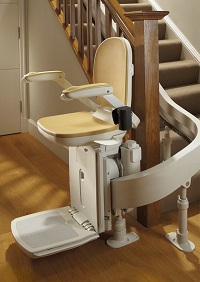 Depending on how safe it is for you to use the stairs, you may need to consider additional stair rails, or installing a stairlift or a through floor lift in your home. Children and those of short stature may find additional stair rails set below the standard rail height helpful.
Depending on how safe it is for you to use the stairs, you may need to consider additional stair rails, or installing a stairlift or a through floor lift in your home. Children and those of short stature may find additional stair rails set below the standard rail height helpful.
Further reading DLF's fact sheet: Choosing equipment to get up and down stairs.
Provision of equipment
There are a few options available for funding of equipment and minor adaptations; this can vary across the UK. We provide an overview of the options available here, but it is worthwhile checking what arrangements are in place locally.
In England, if you are assessed as requiring preventative intervention, equipment under £1000 would be free of charge to you (Department of Health 2014, section 2.9). In Scotland, Local Authorities make their own arrangements for provision of minor adaptations and details can be accessed via your Council website. If the equipment or adaptation costs more that £1000, you may have to apply for a Disabled Facility Grant (Mandelstam 2016).
The Money Advice Service has some useful information about funding for adaptations.
It is recommended that you seek advice from an occupational therapist before considering which equipment is suitable to you. You may be entitled to an assessment by a Local Authority Social Services Occupational Therapist. Alternatively a list of independent Occupational Therapists can be found on The Royal College of Occupational Therapists' website.
Private purchase
If you need advice before you buy, contact your local equipment demonstration centre where you would have the opportunity to try out a range of equipment. There are several of these around the country where you can go for impartial advice. Your local authority will also be able to supply information about where your nearest centre is located. Also Disabled Living Centres and some retailers have showrooms which have areas set up so you can try out items of equipment to see if they will suit you before you commit to making a purchase.
If you are unsure if you can afford the equipment or any of the associated costs, requesting an assessment or advice from an Occupational Therapist or local well-being service (local areas may have different titles for support services) will help with decision-making. It may be that another way of accessing equipment is more suitable for you.
Also consider if you can afford a service contract for more complex items of equipment. These may seem expensive at first but in the long run call out costs or replacements may prove to be costly. Some items such as hoists and slings need to be ‘LOLER’ (Lifting Operations and Lifting Equipment Regulations, 1998) checked. This is because they are used to move people mechanically and these checks are a legal requirement every six months. Others with moving parts or electrics will have a service schedule recommended by the manufacturer which is included in the instruction manual.
Before purchasing, look for a sales company that belongs to a trade association, such as the British Healthcare Trades Association (BHTA). BHTA members have signed up to a code of practice governing standards of customer service (further details are given in the Useful organisations and resources section).
Some suppliers will fit equipment, but some is sold ‘supply only’. Finding a tradesman to fit items may not be easy. There may be a local arrangement for fitting small items such as a care and repair service or Home Improvement Agency or there may be a list of ‘trusted traders’ provided. Websites such as Checkatrade provide feedback from previous customers which can help you find a reputable service provider and Trading Standards may be able to advice if there are concerns over a company you are considering using.
VAT exempt purchases
Equipment which is specifically designed for those with disabilities may be purchased ‘VAT free’. N.B - this is not claimed back via the personal tax system / HMRC, but during your purchase. If you have purchased something which should have been VAT free, it is not possible to claim this back from the supplier or HMRC.
Equipment suppliers may have the VAT exemption form on their website or you can download a general form from the GOV.UK website. You will need to fill in a form for each supplier you use, but you will only need to do this for the first purchase with them.
Disabled Facilities Grants (DFGs)
A local authority Disabled Facilities Grant, often referred to as a DFG, may be available for essential home adaptations for you as a disabled person, if they are deemed ‘necessary to meet your needs’ and the work is ‘reasonable and practical’. This can include extensions and structural work to accommodate fixed hoists, stairlifts, downstairs bathrooms, shower units etc. If this type of adaptation is needed, a local occupational therapist will come to assess your needs and then contact the relevant council departments. The occupational therapist’s recommendations are taken as evidence that the work proposed is appropriate and meets all the requirements for funding.
The occupational therapist will be able to explain the application process. Information is also available from your local authority and on the Government website.
Disability Rights UK have some very comprehensive online information about DFGs and other housing grants.
DFGs operate across England, Wales and Northern Ireland. Conditions for DFGs will vary according to the country in which you live. For details of schemes in Scotland see Disability Information Scotland and Scottish Government (2009) Help with adaptations to your home: A guide for disabled people in private housing in Scotland. Edinburgh: Scottish Government.
Please note that you may not receive any grant if you start work on your property before the council approves your application.
Charitable funding
If you do not have the funds to buy equipment it may be possible to request support from a charity. They will usually have criteria which they will apply, and most will not consider equipment which should be provided by the NHS or Social Services.
Some charities will only consider requests which are supported by an involved professional, usually an occupational therapist, physiotherapist or a nurse. This may require them to be present during the assessment for an item of equipment. This is to ensure that the equipment is appropriate and will not have an impact on planned treatment or rehabilitation programmes.
Equipment is not always purchased outright and gifted to you. Some items are provided on loan, either for a specified length of time, or to be returned when no longer needed or appropriate for use.
A number of charity websites that offer funding are listed here:
- Community Care A list of charities giving grants
- Turn2us Turn2us is a national charity that helps people in financial hardship gain access to welfare benefits, charitable grants and support services.
- My grants Accessibility grants for disabled and older people
- Grants for individuals The Grants for Individuals website is run by the Directory of Social Change and lets subscribers search for grants. It is intended for organisations searching for funding on behalf of individuals.
Prescriptions
Following an assessment some local authorities will issue you with a prescription for the equipment that you need. This can be taken to a local retailer (usually a pharmacy or independent equipment retailer) and you can collect the equipment and begin to use it immediately. Usually there is the option to have the equipment delivered to your home if you have difficulty accessing your local retailers.
Equipment hire
If your need is short term it may be cost effective to hire equipment.
Mobility Hire for example is a national source for mobility and assistive equipment on hire or purchase. They offer short or long term rental solutions to meet most requirements – equipment ranges from wheelchairs to bathroom aids.
If the equipment is required for a holiday it is advisable to look for a supplier near to your destination – they will be able to respond to any issues such as a breakdown / breakage.
NB - equipment from Social Services is provided for use at your home address and should not be used elsewhere as:
- it is assessed as suitable for use in your home and selected to work with your bath / bed / toilet type
- they will not be able to respond to breakdowns or repairs.
However, if you are permanently moving home into the area of another local authority, you can take the equipment with you if you still need to use it and it is the most cost effective solution. You will need to discuss this with the service that issued the equipment to you.
Community equipment store loan
This is available via an NHS employee (Nurse / Occupational Therapist or Physiotherapist) or via a Social Services Occupational Therapy Service.
Loans can either be short term to assist after an operation or illness or longer term to promote independence or support care-giving.
Long term loans are usually the responsibility of Social Services (Adult Social Care / Children’s Services) and will be provided following an assessment by an Occupational Therapist. Straightforward items, such as raised toilet seats or bath seats and boards can be provided by an occupational therapy assistant. Arrangements vary across the UK and you may find that local arrangements allow different services to provide equipment on behalf of each other.
Also, equipment may be offered as an alternative to an adaptation. Your occupational therapist will explain why they are making this suggestion.
DLA / PIP / Attendance Allowance
Disability Living Allowance, Personal Independence Payments and Attendance Allowance are benefits available for those who need support with activities of daily living. Which of these can be claimed depends on the age of the person claiming the benefit. Information on claiming these is available from GOV.UK (https://www.gov.uk) and the Citizens Advice Bureau (https://www.citizensadvice.org.uk/ ); this website has advice specific to each of the home nations and enabling you to check your eligibility if you are not already claiming one of these benefits.
Further advice from us
For clear, practical advice and information on products and suppliers of daily living equipment, please have a look at our Living made easy website.
If you would like further advice related to choosing equipment for everyday living you could try relevant sections of AskSARA, our free online guided advice tool. AskSARA will ask you questions about yourself and your environment and then offer relevant advice, product suggestions and supplier details.
You can contact the DLF Helpline, which is open Monday to Friday from 10am to 4pm. Tel: 0300 999 0004 (calls charged at your standard land line rate even if you are phoning from a mobile).
Alternatively, you may wish to contact us via email: info@dlf.org.uk or by letter: DLF, 34 Chatfield Road, Wandsworth, London SW11 3SE.
To help us give you a concise and informative reply, please provide us with as much detail as possible, including information on the difficulties you are having and any solutions you have considered, such as equipment ideas.
Another source of advice is a disabled or independent living centre where you would have the opportunity to try out a range of equipment. There are several of these around the country where you can go for impartial advice. Your local authority will also be able to give you details of centres in your area.
Further advice from us
For clear, practical advice and information on products and suppliers of daily living equipment, please have a look at our Living made easy website.
If you would like further advice related to choosing equipment for everyday living you could try relevant sections of AskSARA, our free online guided advice tool. AskSARA will ask you questions about yourself and your environment and then offer relevant advice, product suggestions and supplier details.
You can contact the DLF Helpline, which is open Monday to Friday from 10am to 4pm. Tel: 0300 999 0004 (calls charged at your standard land line rate even if you are phoning from a mobile).
Alternatively, you may wish to contact us via email: info@dlf.org.uk or by letter: DLF, 34 Chatfield Road, Wandsworth, London SW11 3SE.
To help us give you a concise and informative reply, please provide us with as much detail as possible, including information on the difficulties you are having and any solutions you have considered, such as equipment ideas.
Another source of advice is a disabled or independent living centre where you would have the opportunity to try out a range of equipment. There are several of these around the country where you can go for impartial advice. Your local authority will also be able to give you details of centres in your area.
Contributors
Marney Walker DipCOT, BA, MA
 Marney Walker is an independent occupational therapist specialising in the design of inclusive and accessible housing. She has over 25 years’ experience in the public sector, principally in housing and social care. Marney has an MA in Inclusive Design and has delivered training and taught at Masters level on the subject. She is an Inclusive Design Assessor for the Civic Trust, a member of the Access Association and London and South East Representative for Royal College of Occupational Therapy-Specialist Section in Housing.
Marney Walker is an independent occupational therapist specialising in the design of inclusive and accessible housing. She has over 25 years’ experience in the public sector, principally in housing and social care. Marney has an MA in Inclusive Design and has delivered training and taught at Masters level on the subject. She is an Inclusive Design Assessor for the Civic Trust, a member of the Access Association and London and South East Representative for Royal College of Occupational Therapy-Specialist Section in Housing.
Ruth Parker
 Ruth Parker qualified as an occupational therapist in 1985 working in roles within the NHS until 2001 when she moved to work in Adult Social Care. In 2005 she moved to her current team working with children with disabilities, their families and carers, supporting independence and care provision in the home. Ruth completed an MSc in Accessibility and Inclusive Design in 2010. Following this she has been working towards a PhD which utilises her experience working with children with disabilities to consider how design choices can affect the play experiences offered by play parks completing this work in December 2018.
Ruth Parker qualified as an occupational therapist in 1985 working in roles within the NHS until 2001 when she moved to work in Adult Social Care. In 2005 she moved to her current team working with children with disabilities, their families and carers, supporting independence and care provision in the home. Ruth completed an MSc in Accessibility and Inclusive Design in 2010. Following this she has been working towards a PhD which utilises her experience working with children with disabilities to consider how design choices can affect the play experiences offered by play parks completing this work in December 2018.
Lucy Rogers
 Lucy Rogers graduated in 2001 from Brunel University with a BSC in Occupational Therapy and completed a Postgraduate Diploma in Accessibility and Inclusive Design at the University of Salford in 2009. She has extensive experience working with both children and adults. Lucy’s passion for home adaptations and inclusive design has developed through many years of professional practice within different sectors and the realisation that without suitable, accessible and safe housing, social welfare and physical and mental health will suffer.
Lucy Rogers graduated in 2001 from Brunel University with a BSC in Occupational Therapy and completed a Postgraduate Diploma in Accessibility and Inclusive Design at the University of Salford in 2009. She has extensive experience working with both children and adults. Lucy’s passion for home adaptations and inclusive design has developed through many years of professional practice within different sectors and the realisation that without suitable, accessible and safe housing, social welfare and physical and mental health will suffer.
Useful organisations and resources
New Loom House
Suite 4.06
101 Back Church Lane
London, E1 1LU
The BHTA is the largest trade association for suppliers and manufacturers of mobility and homecare products. They have a code of practice to which their members sign up. Contact the BHTA to obtain a list of members in your area.
20-21 Red Lion Court
London EC4A 3EB
The Centre for Accessible Environments (CAE) is the UK's leading authority on inclusive design. Their aim is to help secure a built environment that is usable by everyone, including disabled and older people.
Unit 9, The Renewal Trust Business Centre
3 Hawksworth Street
20-21 Red Lion Court
Nottingham, NG3 2EG
Website: careandrepair-england.org.uk
Telephone: 0115 950 6500
Email: info@careandrepair-england.org.uk
Website: careandrepair-england.org.uk
Care and Repair is a small, national charitable organisation set up in 1986. It strives to: ensure that more older people can live independently and with dignity in their own homes for as long as they wish, connect housing, health and social care in ways that improve older people’s whole quality of life and work with older people to influence decisions about housing and the related services which affect their lives.
1st Floor, Mariners House
Unit A, Trident Court
East Moors Road
Cardiff, CF24 5TD
Telephone: 02920 107580
Website: www.careandrepair.org.uk/en/
Care and Repair helps older people in Wales live independently in their own homes, delivering practical help to create safe, warm and accessible homes.
Suite 2.5
Unit A, Trident Court
135 Buchanan Street
Glasgow, G1 2JA
Telephone: 0141 221 9879
Website: www.careandrepairscotland.co.uk
Care and Repair services operate throughout Scotland to offer independent advice and assistance to help homeowners repair, improve or adapt their homes so that they can live in comfort and safety in their own community.
3rd Floor
89 Albert Embankment
London SE1 7TP
Email: info@firststopcareadvice.org
Website: www.firststopcareadvice.org.uk
FirstStop Advice is an independent, impartial and free service offering advice and information to older people, their families and carers about housing and care options for later life. The service is provided by Elderly Accommodation Counsel (EAC) in partnership with a number of other national and local organisations, and brings together a wealth of expertise to help older people explore the options and choices open to them.
Foundations is appointed by the Department of Communities and Local Government to oversee a national network of nearly 200 home improvement agencies (HIAs) and handy person providers across England. HIAs are locally commissioned services that ensure people are able to stay safe, secure and warm and retain independence in their own home. They offer holistic services to their clients, helping to improve a person’s well-being, as well as offering practical solutions around the home.
Website: www.grantsforindividuals.org.uk/default.aspx
The Grants for Individuals website is run by the Directory of Social Change and lets subscribers search for grants. It is intended for organisations searching for funding on behalf of individuals.
Website: www.gov.uk
GOV.UK is the website for the UK government. It's the best place to find government services and information. GOV.UK has a section devoted to providing information for older adults and individuals with a disability.
Further reading:
Care Act fact sheets
Social Services and Wellbeing Act (Wales)
Chronically Sick and Disabled Persons (Northern Ireland) Act 1978 (delivered by the National Archives
Apply for a needs assessment by social services
London Head Office
Holyer House
20-21 Red Lion Court
London EC4A 3EB
Telephone: 020 7822 8700
Email: info@habinteg.org.uk
Website: www.habinteg.org.uk
Habinteg Housing Association champion inclusion and promote accessible homes and neighbourhoods. They also complete research and publications and are actively involved in policy making.
Telephone: 020 7822 8700
The Home Adaptations Consortium is made up of a broad spectrum of national organisations working together with a single aim: to champion quality provision of home adaptations for disabled people. It was initiated in 2008 by Care & Repair England to provide a forum to share and promote good policy and practice. The Consortium aims to identify and highlight the potential impact of wider policy changes e.g. in social care and health reform on the provision of home adaptations and Disabled Facilities Grants (DFGs). The Consortium only operates in England.
Website: www.moneyadviceservice.org.uk
Money Advice Service offer free and impartial money advice, set up by government. Further reading: Major or minor adaptations
Website: www.planningportal.gov.uk
Planning Portal is the first port of call for anyone wanting to find out about the planning system in England and Wales. Its aim is to provide a one-stop-shop supplying answers, services and information to anyone involved in the planning process - from home owners and businesses to planning professionals and Government officials. Further guidance and regulations about access to and use of buildings (Part M): www.planningportal.gov.uk/buildingregulations/approveddocuments/partm/approved
Ground floor, Unit 10, Blenheim Court
62 Brewery Road
London N7 9NY
Telephone: 020 7427 2460
Email: mail@ridc.org.uk
Website: www.ridc.org.uk
RiDC (formerly Ricability), the Research Institute for Disabled Consumers, are a national research charity dedicated to providing independent information of value to disabled and older consumers. Their reports are based on rigorous research and provide practical information needed by disabled and older consumers.
105 Judd Street
London, WC1H 9NE
Telephone: 0303 123 9999
Email: helpline@rnib.org.uk
Website: www.rnib.org.uk
RNIB offers help and support for blind and partially sighted people, from practical and emotional support through to campaigning for change. Further reading: Adapting your home, Practical adaptions.
Tavistock House South (Entrance D)
Tavistock Square
London WC1H 9LG
Telephone: 020 8995 0880
Email: info@pocklington-trust.org.uk
Website: www.pocklington-trust.org.uk
The Thomas Pocklington Trust is dedicated to improving the lives of people who are blind or partially sighted. Their guides offer advice and information on home adaptations, interior design, lighting and more for people with sight loss.
Released April 2019, to be reviewed by April 2022, Version 1
References and further reading Show references
BS8300 (2018) Design of an accessible and inclusive built environment. Part 2: Buildings Code of Practice BSI Standards Publication
Building Regulations: England (2013) Approved Document K Protection from falling, collision and impact. Available from www.planningportal.co.uk/info/200135/approved_documents/73/part_k_-_protection_from_falling_collision_and_impact
Building Regulations: England (2015 edition incorporating 2016 amendments) Approved Document M - Access to and use of buildings: Volume 1 - Dwellings. Available from www.planningportal.co.uk/info/200135/approved_documents/80/part_m_-_access_to_and_use_of_buildings
Building Regulations: England (2006 edition incorporating 2010 and 2013 amendments). Available from Approved Document B (Fire safety) – Volume 1: Dwelling houses
HSE (2015). Managing health and safety in construction :Construction (Design and Management) Regulations: Guidance on Regulations. Available from www.hse.gov.uk/pubns/priced/l153.pdf
Dalke, H. (2013) Designing House Entrances for People with Sight Loss: A Guide Available from www.pocklington-trust.org.uk/project/house-entrances-for-sight-loss/
Equality Act 2010. Available from www.legislation.gov.uk/ukpga/2010/15/pdfs/ukpga_20100015_en.pdf
Government Equalities Office (2010) Equality Act 2010 What do I need to know? Disability Quick Start Guide
Habinteg (2018). Wheelchair Housing Design Guide (3rd Ed) Centre for Accessible Environments (CAE), Royal College of Occupational Therapists Specialist Section in Housing (RCOTSS-Housing) Royal Institute of British Architects (RIBA).
Home Modification Information Clearing House. Available from www.homemods.info/home-mods
Department of Transport (2013). Can I get a Blue Badge? A guide from the Department of Transport for people living in England. Available from assets.publishing.service.gov.uk/government/uploads/system/uploads/attachment_data/file/197719/can-i-get-a-blue-badge.pdf
Powell, J et al (2017) Room to Improve: The role of home adaptations in improving later life. Centre for Ageing Better, UWE Bristol, BRE. Available from www.ageing-better.org.uk/publications/room-improve-role-home-adaptations-improving-later-life
Thomas Pocklington Trust (2013) Making an entrance: Colour contrast and design of entrances to homes of people with sight loss. Research findings available from pocklington-trust.org.uk/wp-content/uploads/2016/02/Making-an-Entrance-1.pdf
Secured By Design - Homes (2016). Parts of this guidance of relevance to home owners or occupiers – Section 1 of this document provides guidance on the external environment around the dwelling, whilst Section 2 provides detailed information regarding the physical requirements which may be applied to existing homes that will radically improve the security of the home. Available from: www.securedbydesign.com/images/downloads/SBD-HOMES-2016.pdf
Muscular Dystrophy Adaptations Manual (2nd Ed.) : for children and adults with muscle-wasting conditions. Available from www.musculardystrophyuk.org/wp-content/uploads/2017/04/INF23-A-%C2%AD-Adapt-web.pdf
National Fire Chiefs Council - Fire Safety in Specialised Housing. Available from www.nationalfirechiefs.org.uk/write/MediaUploads/NFCC%20Guidance%20publications/NFCC_Specialised_Housing_Guidance_-_Copy.pdf
Powell, J, Mackintosh, S, Bird, E, Ige,J., Garrett, H., Roys, M, (2017). Room to improve:The role of home adaptations improving later life. Centre for Ageing Better, University of West England and BRE. Available from www.ageing-better.org.uk/sites/default/files/2017-12/Room%20to%20improve.%20The%20role%20of%20home%20adaptations%20in%20improving%20later%20life.pdf
AskSARA
If you would like further advice regarding daily living equipment related to choosing equipment for everyday living you could try relevant sections of AskSARA. AskSARA is our free online guided advice tool. AskSARA will ask you questions about yourself and your environment and then offer relevant advice, product suggestions and supplier details.
| Attachment | Size |
|---|---|
| 24.99 KB | |
| 9.37 KB | |
| 42.46 KB | |
| 47.66 KB | |
| 24.18 KB | |
| 27.55 KB | |
| 20.89 KB | |
| 31.83 KB | |
| 34.05 KB | |
| 699.83 KB |
All rights reserved. No reproduction or transmission of this publication may be made without written permission. Inclusion (including any sponsorship) does not indicate endorsement or that any item has been recommended or tested. All information is provided without legal responsibility.
Disabled Living Foundation, Tel: 020 7289 6111, Fax: 020 7266 2922, Helpline: 0300 999 0004 10.00am-4.00pm, Email: helpline@dlf.org.uk, Website: www.dlf.org.uk
Reg. Charity No: 290069, VAT Reg. No: 226 9253 54
 (Tell me about the standard)
(Tell me about the standard)

Your personal information is required in order to claim Gift Aid. This information is kept by DLF/Shaw Trust for financial audit purposes. For more information on our privacy policy visit: https://www.dlf.org.uk/content/privacy-policy










